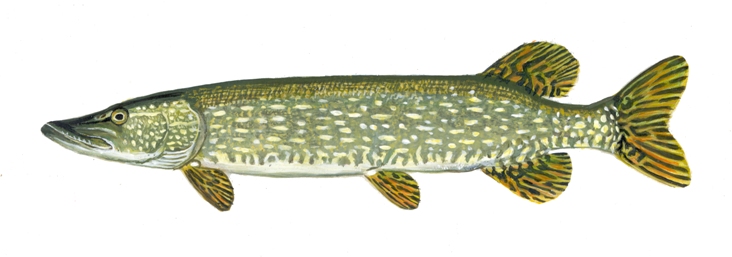

By Dave and Sheree Swistun
A prehistoric predator stalks the deep, murky waters — moving with the ease and grace of a silver arrow, relentlessly hunting its prey. With rows of needle- sharp teeth, merciless “dead” eyes reminiscent of a shark’s, an almost snakelike body and a survival instinct that has changed little over millions of years, the northern pike is an adversary worthy of any angler’s skills and best efforts.
One of the most prized game fish in northern United States and southern Canada, their range has been extended over the decades through effective stocking programs — and these days any lake in these regions that ices over in winter is likely to have a population of northern pike.
Pike can grow to a respectable size, and they have a reputation as fierce fighters once they’re hooked. Even when they’re landed, it’s no time to let down your guard. Those nasty teeth can do a bang-up job, and more than one careless fisherman has lost a finger by giving an angry northern the opportunity to put its teeth to use.
Springtime Is Northern Pike Season
Experienced anglers generally agree that the May is prime time for northern pike. They’ve finished spawning, and they’re hungry — prowling shallow water for panfish and just about anything else that moves and looks tasty. Weedy structure hasn’t yet grown extensively, but the pike will seek out any cover they can find. Shallow bays, reed beds and the edges of lily pads and slop are often the most productive during this period. Pike haven’t been fished hard in months, so they’ll readily take a lure in early spring.
Summer and Fall Northern Pike Fishing
The warmer water of summertime pushes the northern pike into deeper depths, and they will roam over large areas looking for schools of small fish. Smaller pike will often opt to stay close to weedy cover, waiting for their prey to swim by. In the fall as the water cools, you can still find northerns in deeper water, but they’ll start heading back to the shallow areas that they occupied in the spring. Where you can find baitfish in the fall, you’ll be in northern pike territory. Like spring, the fall also is prime time for northern pike fishing as they are aggressively eating and preparing for the up-coming winter months.
Equipment And Plan of Attack
Many veteran northern pike anglers prefer a six to seven-foot, medium-heavy to heavy-action pole, depending on the bait. The pole should be limber enough to ensure good casting qualities, but heavy and stiff enough to handle a big, feisty pike putting up its best fight.
Baitcasting reels are standard fare, tough and dependable enough to handle heavy action. Monofilament and braided line are both good choices (minimum 20-pound test for mono, 50-pound test for braided).
Wire leaders are a must for pike, as their sharp teeth will make short work of unprotected line. Generally, a 20 to 30-pound wire leader about 12 inches long will suffice. While the average weight of a northern pike is between three and seven pounds (24 to 30 inches in length), make sure your setup can handle catches in the 10 to 20-pound range, which aren’t uncommon. (The largest northern pike caught was 68 pounds). Northern pike are ferocious fighters, so sturdy equipment is always recommended.
Pike respond well to a variety of lures, but in spring anglers favor the trusty spoon, about five inches in length. Fishermen will argue endlessly about what colors are most attractive, but silver, red, yellow and gold have always been reliable shades for northern pike. A slow retrieve with a spoon seems to best attract a pike’s attention.
Spinner baits, buzz baits and bucktails — all in large sizes — also are quite productive, especially when working the weeds in shallow water.
As the water begins to warm in late spring, jigs and plugs produce results, running at about 10 feet deep. Late spring is also the time to break out topwater lures — again in the larger sizes — worked slowly over the weed beds, especially early morning and approaching dusk.
In the warmer summer months, any lure that mimics the prey that the northern are feeding on such as minnow baits will be productive. In the fall, use large crank baits and spoons trolled relatively fast. Match the color of your lure to the species of prey the northern pike will be feeding on.
Fishermen need to be careful when handling a northern, as they are capable of inflicting nasty wounds. Keep your pliers handy to retrieve lures, and consider using mouth spreaders, if available. Northern pike offer the opportunity for some of the best fishing, and they’re not difficult to harvest. You’ll find they provide some good eating, too.
Dave and Sheree Swistun are owners of Duck Bay Lodge, a fishing resort located in Lake of the Woods, Ontario, Canada. Built more than 60 years ago, they are the fourth owner, having purchased Duck Bay Lodge in 1988. *Photo credit.
 Views expressed by guest bloggers are their own and do not represent the views of Camo is the New Black, its proprietors or affiliates. Interested in writing a guest post? Send us an email at info@camoisthenewblack.com
Views expressed by guest bloggers are their own and do not represent the views of Camo is the New Black, its proprietors or affiliates. Interested in writing a guest post? Send us an email at info@camoisthenewblack.com




Very interesting post. These are great eating – I remember from Minnesota!